Welcome to CounterTobacco.org’s “News and Research Roundup!” Each month we post a summary of the latest research, reports, and news stories on counteracting tobacco product sales and marketing at the point of sale (POS). Keeping up with what’s happening in the POS movement all across the country can help you choose policies and strategies that work best for your community. New research can help provide support for your work and evidence for the importance of the “War in the Store.” Have a story you don’t want us to miss? E-mail it to us!
New Research
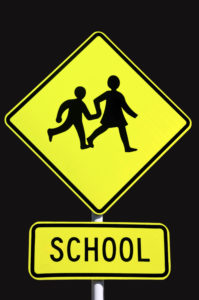
Disparities, Density, and Proximity
- Reducing Disparities in Tobacco Retailer Density by Banning Tobacco Product Sales Near Schools, Nicotine & Tobacco Research
- A study examining tobacco retailer density in both Missouri and New York found that density was higher in low-income, racially diverse, and African-American neighborhoods. However, if a policy were put in place that banned tobacco retailers within 1000 feet of schools, most of the disparities in retailer density between neighborhoods would be eliminated. Learn more about disparities in retailer density.
- Association Between Distance From Home to Tobacco Outlet and Smoking Cessation and Relapse, JAMA Internal Medicine
- An analysis of two longitudinal studies of current smokers in Finland found that smokers who lived farther away from a tobacco outlet were more likely to successfully quit, where a 500 meter (1/3 mile) increase in the distance that the smoker lived from a tobacco outlet was associated with a 20% to 60% increase in the odds of quitting smoking. Walking distance to a tobacco outlet did not appear to influence relapse for ex-smokers.
- News Story: Longer distance to tobacco shop tied to better odds of quitting, Reuters
- Inequities in tobacco retailer sales to minors by neighborhood racial/ethnic composition, poverty and segregation, USA, 2015, Tobacco Control
- An analysis of 2015 FDA inspections of tobacco retailers showed that retailers located in neighborhoods with a higher proportion of residents who were American Indian, Black, Latino, or poor were more likely to sell to minors. Retailers in neighborhoods with a higher proportion of residents who are White or aged 10-17 were less likely to sell to minors. The authors suggest that regulatory agencies should consider oversampling in areas where retailers are more likely to sell to minors, and that policies that reduce inequities in youth access to tobacco should be implemented.
- Tobacco outlet density near home and school: Associations with smoking and norms among US teens, Preventive Medicine
- This study found that 41% of teens in the US live within a half mile of a tobacco retail outlet, and 44.4% attended school within 1000 feet of a tobacco retail outlet. Regardless of income, African-American teens were more than twice as likely to live near a tobacco retailer. Teens who lived in areas with higher tobacco outlet density were more likely to have tried smoking, and more likely to think that more adults smoke. The authors emphasize the importance of policy interventions that focus on home neighborhood environments in addition to the environment around schools.
- Learn more about licensing as a way to restrict where tobacco can be sold and reduce retailer density.
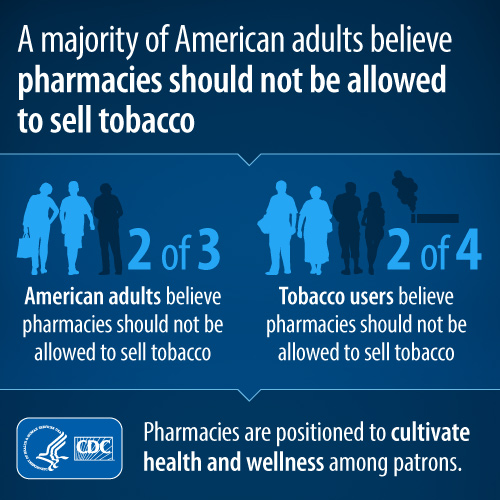 Tobacco and Pharmacies
Tobacco and Pharmacies
- Attitudes Toward Prohibiting Tobacco Sales in Pharmacy Stores Among U.S. Adults, American Journal of Preventive Medicine
- Overall, 66.1% of adults who were surveyed “strongly” or “somewhat” favored prohibiting the sale of tobacco products in pharmacies, including half of current smokers.
- Prices for Tobacco and Nontobacco Products in Pharmacies Versus Other Stores: Results From Retail Marketing Surveillance in California and in the United States, American Journal of Public Health
- This study compared prices for cigarettes (Marlboros, Newports, and the cheapest cigarettes) and bottled water in a 2014 sample of California retailers and a 2012 sample of retailers from across the United States. They found that cigarettes were cheaper in pharmacies than in other stores (convenience stores, liquor stores, small grocery stores, and supermarkets), whereas bottled water, a healthy product, was more expensive in pharmacies. In addition, Newport cigarettes were cheaper in areas with higher proportions of African American residents.
- News Story: U.S. pharmacies sell cigarettes for less than other stores, Reuters
- Learn more about tobacco free pharmacies
E-Cigarettes
- What is the impact of e-cigarette adverts on children’s perceptions of tobacco smoking? An experimental study, Tobacco Control
- UK Children ages 11-16 who had never smoked or used e-cigarettes viewed occasional smoking as less harmful after viewing advertisements for e-cigarettes compared to those who were not exposed to the advertisements.
- News story: E-cigarette ads may cause children to underestimate smoking risks – study, The Guardian

- Exposure to Advertisements and Susceptibility to Electronic Cigarette Use Among Youth, Journal of Adolescent Health
- According to data from the 2014 National Young Tobacco Survey, 53.2% of middle and high school students were exposed to e-cigarette advertising in stores at medium to high frequencies. Those who were more frequently exposed to e-cigarette advertising in stores were 2.8 times more likely to be current e-cigarette users. Current cigarette smokers, and youth who lived with others who used e-cigarettes, were also more likely to be current e-cigarette users.
- Unicorns cartoons: marketing sweet and creamy e-juice to youth, Tobacco Control
- A wide assortment of unicorn-themed e-juice products are currently on the market, which are usually sweet, fruity, and creamy flavors that appeal to youth. Other cartoon characters, such as Joe Camel, have been discontinued since the 1998 Master Settlement Agreement on the basis of youth appeal. The authors suggest that a similar cartoon ban may be warranted for the e-cigarette industry as well.
- Learn more about e-cigarettes at the point of sale
Other
- Cigarette prices and community price comparisons in US military retail stores, Tobacco Control
- Military installations set tobacco prices based on the “most competitive commercial community price.” However, this study found that the average price for a pack of Marlboro cigarettes in US military retail stores was similar to the average lowest community price, but almost a dollar less (13.7% lower) than the highest community price. Prices were lowest in military installations on US Marine Corps bases, which is the military branch with the highest smoking rate. Sales in military exchanges are not subject to state or local sales tax, although the Department of Defense recently instructed all branches to set tobacco prices “match the prevailing local pricing in the community, including the effect of all applicable taxes that local consumers pay. However, as the authors note, neither “local” nor “prevailing” are defined. In addition, 18.2% of military exchange prices violated their pricing instructions. Consequently, the authors suggest a minimum price policy for tobacco products in military installations.
- Small Food Store Retailers’ Willingness to Implement Healthy Store Strategies in Rural North Carolina, Journal of Community Health
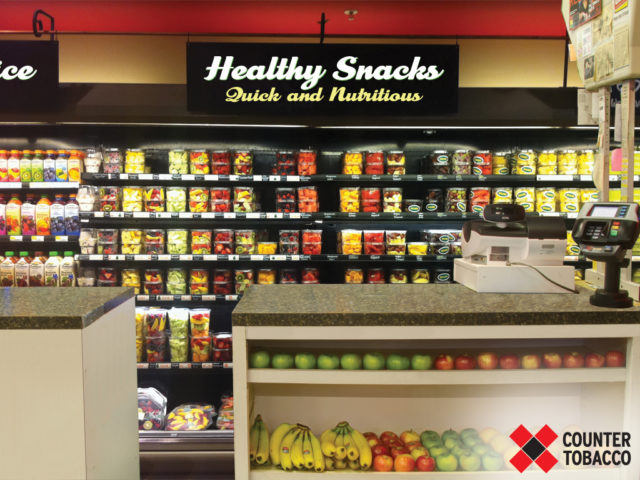 Researchers assessed 55 small food store retailers in three rural North Carolina counties for their willingness to implement healthy store strategies to increase the availability, display, and promotion of healthy foods, and to decrease the availability, display, and promotion of tobacco products. Over half of stores were willing to stock low/non-fat milk, whole wheat bread, and fresh produce, as well as display healthy snacks at checkout. However, nearly all were unwilling to reduce the availability or marketing of tobacco in their stores. Nearly all of 55 small food store retailers that were assessed in three rural North Carolina counties sold smokeless tobacco and cigars, and 72% sold e-cigarettes. The authors suggest that restrictions on tobacco sales and marketing may be more feasible through local tobacco control ordinances or included in healthy foods ordinances.
Researchers assessed 55 small food store retailers in three rural North Carolina counties for their willingness to implement healthy store strategies to increase the availability, display, and promotion of healthy foods, and to decrease the availability, display, and promotion of tobacco products. Over half of stores were willing to stock low/non-fat milk, whole wheat bread, and fresh produce, as well as display healthy snacks at checkout. However, nearly all were unwilling to reduce the availability or marketing of tobacco in their stores. Nearly all of 55 small food store retailers that were assessed in three rural North Carolina counties sold smokeless tobacco and cigars, and 72% sold e-cigarettes. The authors suggest that restrictions on tobacco sales and marketing may be more feasible through local tobacco control ordinances or included in healthy foods ordinances.- Learn more about healthy retailers.
- Use of imagery and text that could convey reduced harm in American Spirit advertisements, Tobacco Control
- In 2015, the FDA issued warnings to tobacco companies regarding their use of the terms ‘natural’ and/or ‘additive-free,’ which falsely convey reduced harm. However, researchers’ analysis of American Spirit advertisements show that the brand uses additional terms and techniques to convey the same message, including references to small, local, or organic farming, eco-friendly practices, and images of farming or nature.
- Learn more about policies that restrict tobacco product packaging.
- Invited Commentary: Retail Stores and the Fight Against Tobacco – Following the Money, JAMA Internal Medicine
- To learn more, review the Deadly Alliance Report
- Tobacco Control in the Obama Era – Substantial Progress, Remaining Challenges, New England Journal of Medicine
- The Australian experience following plain packaging: the impact on tobacco branding, Addiction
- Industry watch: heat-not-burn tobacco products are about to reach their boiling point, Tobacco Control
- Editorial: Early history of LGBT tobacco control: CLASH at 25, Tobacco Control
- Editorial: The tobacco industry’s deadly distortions of history, Tobacco Control
New Reports
- Cochrane Review: Electronic cigarettes for smoking cessation
Industry News
- The White House Saved Flavors, But for How Long?, CSP Magazine
- Opinion: Tobacco Battleground: Local, State Case Studies, CSP Magazine
- Local Tobacco Restrictions Multiply, CSP Daily News
- Walgreens Shareholders Want Chain to Stop Selling Tobacco, Convenience Store News
- C-store Retailers Face Higher Fines for Tobacco Violations, Convenience Store News
- Federal judge rules label change does not make for new tobacco product, Winston-Salem Journal
- Boehner joins board of tobacco giant Reynolds American, The Hill
POS Policy in the Media
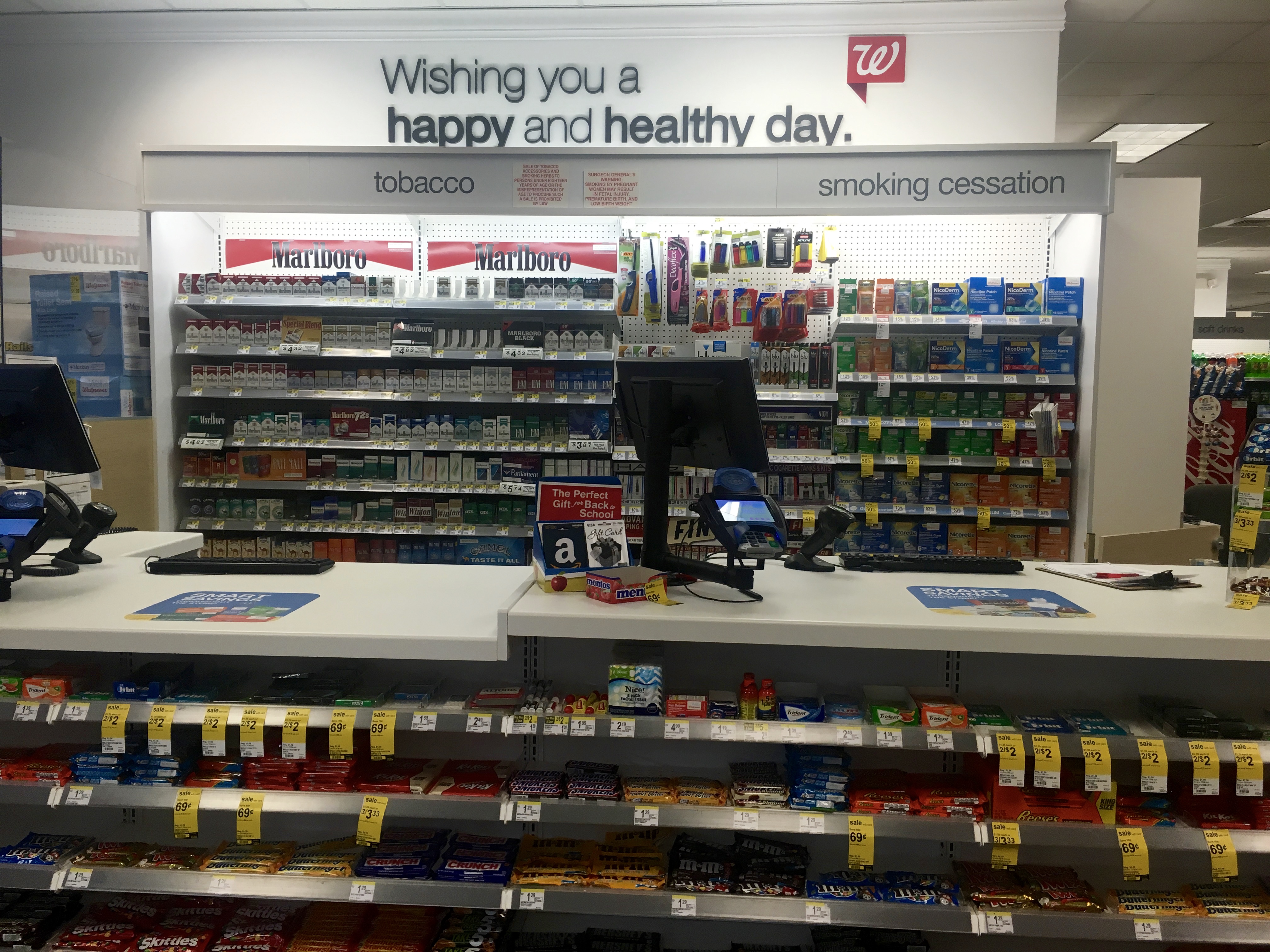
Healthy Retailers and Retailer Reduction
- Fewer cigarettes, more fruits, veggies at tobacco stores, Des Moines Register
- Pharmacies urged to ban tobacco, The Hill
- Most Americans Don’t Want Tobacco on Drug Store Shelves, HealthDay
- Philadelphia’s Board of Health adopts restrictions on tobacco sales, Philadelphia Inquirer
- Interactive: More towns capping tobacco sales permits, Wicked Local Wellesley
E-Cigarettes
- UNC scientists: E-Cigarettes not best way to stop smoking, News & Observer
- E-cigarettes tried by more than half of Arizona high-schoolers, Arizona Daily Star
- Tobacco Industry Works to Block Rule on E-Cigarettes, New York Times
Tobacco 21
- Grafton, Mass. Raises Tobacco Purchase Age to 21, HalfWheel
- New Pittsfield tobacco regulations will bring buying age up to 21, expand buffer zone around day care centers, Berkshire Eagle
- [Lee’s Summit, MO] Council Passes Ordinance Changing Legal Age of Purchasing Tobacco Products to 21, Lee’s Summit Tribune
- St. Louis county takes a big step in banning tobacco sales to those under 21, St. Louis Post-Dispatch
- Cattaraugus County to raise purchasing age, WKBW Buffalo
- Northhampton raises legal tobacco age to 21 and limits the sale of flavored products, MassLive
Menthol and Flavored Tobacco
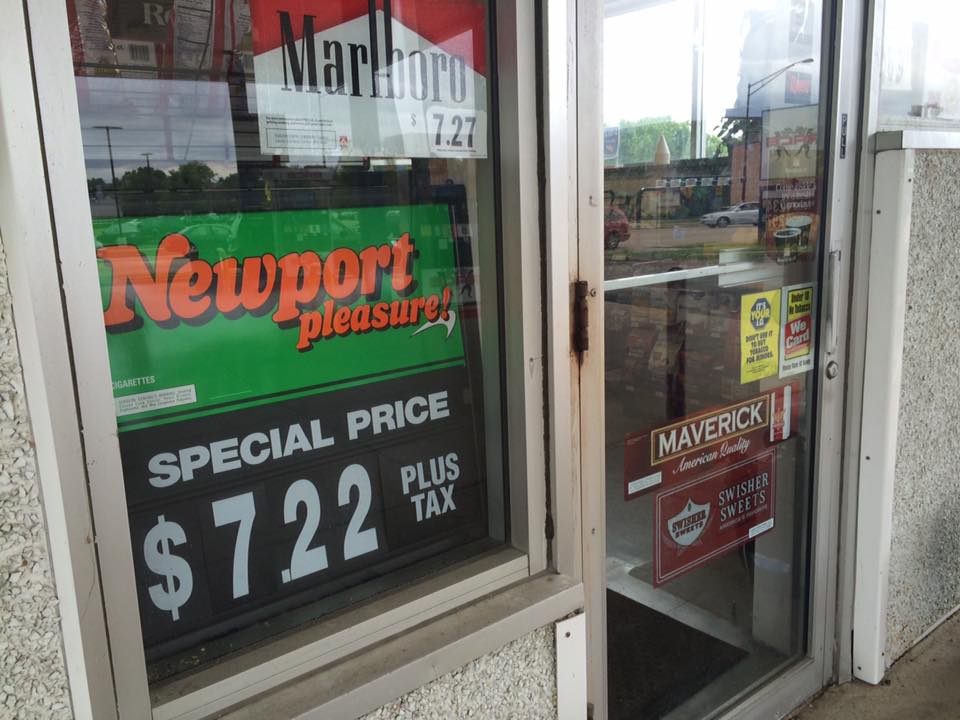
- Black Health Experts Renew Fight Against Menthol Cigarettes, New York Times
- Black Lives/Black Lungs Clears Smoke on Menthol, Milwaukee Courier
- Marion to Ban Synthetic Drugs, Menthol Cigarettes, The Wanderer
- Bourne Board of Health Amends Tobacco Regulations, The Bourne Enterprise
- Are local stores enticing children to become regular tobacco users?, Norwalk Reflector
- Black Doctors Call on Obama to Ban Menthol Tobacco Products, NBC News
- Yolo County Supervisors crack down on youth tobacco use, Daily Democrat
- Tobacco, e-cigarette marketing targets kids, Helena Independent Record
Find more stories in last month’s News and Research Roundup.
Know of a story that we missed? Email us, and we’ll be sure to include it in next month’s roundup!


